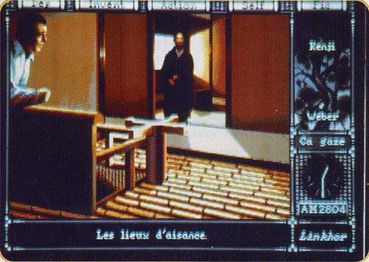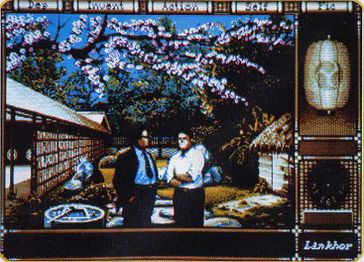Sukiya (lost build of cancelled PC point-and-click adventure game; 1990-2001): Difference between revisions
No edit summary |
m (Minor changes) |
||
| Line 6: | Line 6: | ||
}} | }} | ||
'''''Sukiya''''' was originally developed as a point-and-click adventure game set in Japan, developed by Lankhor. | '''''Sukiya''''' was originally developed as a point-and-click adventure game set in Japan, developed by Lankhor. The main designer, Jérôme Lange, also authored point-and-click adventures ''Mortville Manor'' and ''Maupiti Island'', with this intended to be a sequel. | ||
==History== | ==History== | ||
The game was announced as early as 1990 with preview screenshots that were considered impressive for the time. Unfortunately, poor sales on Lankhor's | The game was announced as early as 1990 with preview screenshots that were considered impressive for the time. Unfortunately, poor sales on Lankhor's ''Black Sect'' in 1993 put a halt on the development on ''Sukiya'', where he probably saw it as a sign to stop making adventure games. | ||
Development resumed in the early 2000s, | Development resumed in the early 2000s, this time attempting to make the game 3D. However, the Lankhor studio got shut down in late 2001, cancelling ''Sukiya'' for good. | ||
The Lankhor website shows development art, sprites and screenshots. | ==Availability== | ||
The Lankhor website shows development art, sprites and screenshots, but the game itself has never been released in any way. It's unknown exactly how much of the game was developed. | |||
==Gallery== | ==Gallery== | ||
<gallery mode=packed heights= | {{#ev:youtube|https://www.youtube.com/watch?v=Fjqezzqzuhc|320x240|center|Video (in French) about the game's development history|frame}} | ||
<gallery mode=packed heights=175px> | |||
Sukiya screenshot 2.jpg|One of the original preview screenshots. | |||
Sukiya screenshot 3.jpg|One of the original preview screenshots. | |||
</gallery> | </gallery> | ||
==External links== | ==External links== | ||
*[http://www.lankhor.net/jeux.php?jeu=27&menu=images Development images from Lankhor website] | *[http://www.lankhor.net/jeux.php?jeu=27&menu=images Development images from Lankhor website] | ||
==References== | |||
<references/> | <references/> | ||
[[Category:Lost video games]] | [[Category:Lost video games]] | ||
Revision as of 12:27, 1 May 2017
Sukiya was originally developed as a point-and-click adventure game set in Japan, developed by Lankhor. The main designer, Jérôme Lange, also authored point-and-click adventures Mortville Manor and Maupiti Island, with this intended to be a sequel.
History
The game was announced as early as 1990 with preview screenshots that were considered impressive for the time. Unfortunately, poor sales on Lankhor's Black Sect in 1993 put a halt on the development on Sukiya, where he probably saw it as a sign to stop making adventure games.
Development resumed in the early 2000s, this time attempting to make the game 3D. However, the Lankhor studio got shut down in late 2001, cancelling Sukiya for good.
Availability
The Lankhor website shows development art, sprites and screenshots, but the game itself has never been released in any way. It's unknown exactly how much of the game was developed.
Gallery
External links
References
- ↑ abandonware-france.org page on Sukiya, featuring multiple screenshots. Retrieved 06 Nov '13.


